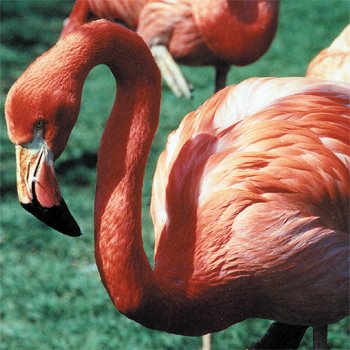Greater Flamingo
This strange-looking bird is known for its long neck, long legs, and pink color.

The greater flamingo is found in the Americas from the Bahamas to Tierra del Fuego, including the Galapagos Islands and from southern Europe to South Africa across to India.
This strange-looking bird is known for its long neck, long legs, and pink color. Its plumage is tinged with pink except for the black flight feathers. Having very tough skin on its legs, it can withstand extremely alkaline soda and salt lagoons which would take the skin from a person’s legs in seconds. The flamingo’s knees are really the ankles and when it sits, the ankles bend backwards.
Flamingos live in great flocks around lakes and lagoons where food can readily be found. Their diet consists of protozoa, algae, crustaceans, mollusks, and insects. The pink color of the plumage actually comes from chemicals called carotenoids, which are contained in the algae eaten.
When feeding, it wades through the water with neck lowered and head upside down, swinging from side to side. The tongue acts like a pump pulling in the water and food as a row of bony plates sieves the food from the water. The flamingo then filters the water out. The combination of backward-pointing spines on their palate and a unique tongue guides the particles down the throat.
Flamingos breed in great colonies. The male and female together build the nest, which is located in the center of a huge mud flat where predators can’t reach it. The nest is a mound of mud 12 to 20 inches (4.73 to 7.88 cm) in diameter with a depression on top for the egg. It has to be tall enough to keep the egg away from any spray that might blow up.
A single egg is laid and is incubated by both parents for approximately 30 days. The parents feed regurgitated liquid called “crop-milk” to the chick until it is able to feed itself. The bill of the hatchling is not curved when it is born but will develop its characteristic shape later. The chicks can swim in 10 days and it takes about 10 weeks for them to grow their feathers.
The main enemy of the flamingo is the fish eagle that picks off young flamingos. Other enemies are hyenas, cheetahs, and jackals.
In ancient Rome, flamingo tongues were a delicacy. Flamingos and their eggs were also eaten until recently.
The flamingo has to build up speed for a long take-off, but once in the air they fly very well with slow, lazy wingbeats.
Greater Flamingo
Phoenicopteriformes • Phoenicopteridae
Phoenicopterus ruber
Weight: 6 to 7 pounds (2.72–3.18 g)
Length: 50–78 inches (127–200 cm)
Wing Span: 70 inches (187 cm)
Life Span: 27 to 50 years
Special Design Feature: The bill of the flamingo is lined with a filter
of bony plates to trap planktonic food and keep large particles of soil and
other debris out.
Did you know? The knees of the flamingo are really the ankles and bend
backwards when the bird sits down.
Marvels of Creation: Breathtaking Birds
This spectacular book brings the world of feathered creatures alive in a unique and colorful way.
Browse Kids Book- © 2024 Answers in Genesis
- Privacy Policy
- Contact
- About

